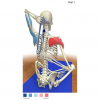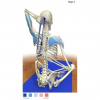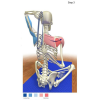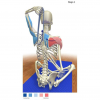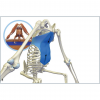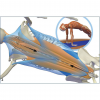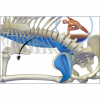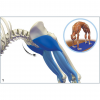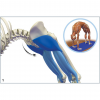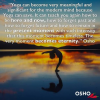spliffendz
Well-Known Member
Gravity and Side Plank
.
The shoulder is the most mobile articulation in the body. The muscular stabilizers, including the rotator cuff play an important role in maintaining the congruency of the shoulder joint. When the capsule and ligaments are loose, then the muscles must compensate. This is why we focus on strengthening the muscles... (to gain stability).
.
Img1 - ...in this (1st) position, the body weight is directed at an angle to the alignment of the arm bones. When the hand is placed below the shoulder, the supporting arm is aligned in a position such that the bones are perpendicular to the direction of gravity. Practicing the pose in this (2nd) way requires less muscular effort because it uses the inherent passive strength of the bones to aid in supporting the body weight. When the hand is placed forward of the shoulder, greater muscular effort is required to maintain the pose.
.
Img2 - People with joint hypermobility depend to a greater degree on the muscular stabilizers of the joint. Placing the hand so that the arm is angled against gravity means that these muscles must also work to support the body weight that would be borne, in part, by the bones. You can experience this concept yourself by standing near a wall and leaning against it. Then, move the feet a bit further from the wall. Which one requires less muscular effort?
.
Img3 - Vasisthasana with the supporting muscular stabilizers. I go over a step-wise approach to engaging these muscles and the other core stabilizers of the trunk and legs in Yoga Mat Companion Four Anatomy for ArmBalances and Inversions.
.
Img4 - The three factors that contribute to mobility and stability of a joint are the bone shape, the capsulo-ligamentous structures and the muscles surrounding the articulation (1-supraspinatus, 2-subscapularis, 3-infraspinatus, 4-triceps, 5-biceps(short head), 6-biceps(long head), 7-deltoid, 8- pectoralis major, 9-pectoralis minor)
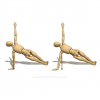
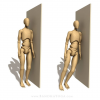
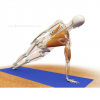
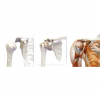
.
The shoulder is the most mobile articulation in the body. The muscular stabilizers, including the rotator cuff play an important role in maintaining the congruency of the shoulder joint. When the capsule and ligaments are loose, then the muscles must compensate. This is why we focus on strengthening the muscles... (to gain stability).
.
Img1 - ...in this (1st) position, the body weight is directed at an angle to the alignment of the arm bones. When the hand is placed below the shoulder, the supporting arm is aligned in a position such that the bones are perpendicular to the direction of gravity. Practicing the pose in this (2nd) way requires less muscular effort because it uses the inherent passive strength of the bones to aid in supporting the body weight. When the hand is placed forward of the shoulder, greater muscular effort is required to maintain the pose.
.
Img2 - People with joint hypermobility depend to a greater degree on the muscular stabilizers of the joint. Placing the hand so that the arm is angled against gravity means that these muscles must also work to support the body weight that would be borne, in part, by the bones. You can experience this concept yourself by standing near a wall and leaning against it. Then, move the feet a bit further from the wall. Which one requires less muscular effort?
.
Img3 - Vasisthasana with the supporting muscular stabilizers. I go over a step-wise approach to engaging these muscles and the other core stabilizers of the trunk and legs in Yoga Mat Companion Four Anatomy for ArmBalances and Inversions.
.
Img4 - The three factors that contribute to mobility and stability of a joint are the bone shape, the capsulo-ligamentous structures and the muscles surrounding the articulation (1-supraspinatus, 2-subscapularis, 3-infraspinatus, 4-triceps, 5-biceps(short head), 6-biceps(long head), 7-deltoid, 8- pectoralis major, 9-pectoralis minor)






